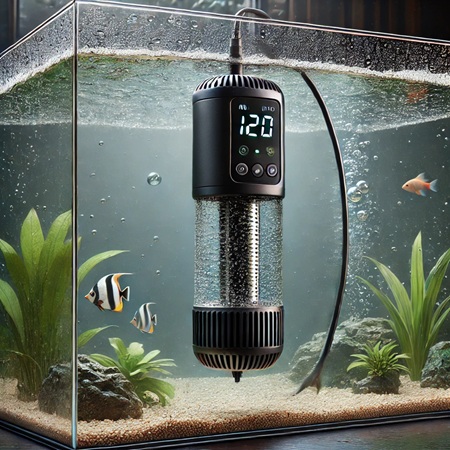Maintaining a stable and appropriate water temperature is crucial for the health and well-being of your aquarium’s inhabitants. Whether you keep freshwater or saltwater fish, having the right aquarium heater is essential. Here’s a guide on what to consider when purchasing an aquarium heater for your home aquarium.
Types of Aquarium Heaters
There are several types of heaters available, each with unique benefits:

Submersible Heaters
- Fully submerged in water
- Provide even heat distribution
- Usually placed near the filter for efficient circulation
- Best for most aquarium setups
Hanging/Immersible Heaters
- Partially submerged with the control unit above water
- Less efficient than submersible models
- More suitable for small aquariums and beginner setups
In-Line Heaters
- Installed in the return line of an external canister filter
- Heat water externally before returning it to the tank
- Best for larger tanks with external filtration systems
Substrate Heaters
- Heating cables placed beneath the substrate
- Commonly used in planted aquariums to promote root growth
- Not a primary heat source, usually paired with another heater
Heater Size and Wattage
Choosing the right wattage ensures that your aquarium stays at the desired temperature. As a general rule:
- 5 watts per gallon of water is ideal.
- Example: A 20-gallon tank requires a 100-watt heater.
- Larger tanks may require multiple heaters to ensure even heat distribution.
Consider factors such as room temperature fluctuations and the species you are keeping when determining the necessary wattage.
Adjustable Temperature Control
A good heater should have an adjustable thermostat with a temperature range suitable for your fish. Look for:
- A precise thermostat to adjust temperatures as needed.
- An easy-to-read temperature scale to monitor settings.
- A heater that maintains a stable temperature without large fluctuations.
For tropical fish, a temperature range of 75-82°F (24-28°C) is common.
Built-In Safety Features
To protect both your fish and your equipment, look for safety features such as:
- Automatic shutoff to prevent overheating.
- Shatterproof or durable casing (especially for glass heaters).
- Water level sensors to prevent operation when not fully submerged.
- Overheat protection to turn off the heater if the temperature gets too high.
Material and Durability
Aquarium heaters come in different materials:
- Glass Heaters: Affordable but prone to breaking.
- Plastic or Shatterproof Heaters: More durable and safer for active fish.
- Titanium Heaters: Highly durable, resistant to breakage, and often used in larger or saltwater aquariums.
If you have large, active fish (such as cichlids or arowanas), a shatterproof or titanium heater is recommended to prevent accidental breakage.
Placement and Mounting Options
The ideal placement depends on the heater type:
- Near the filter outflow: Helps distribute heat evenly.
- Horizontally near the bottom of the tank: Recommended for submersible heaters.
- Multiple heaters for larger tanks: Ensures even heat distribution in tanks over 50 gallons.
Energy Efficiency
An energy-efficient heater helps reduce electricity costs. Look for:
- Models with energy-saving technology that regulate temperature efficiently.
- Digital heaters that maintain precise temperature control with minimal fluctuations.
- Thermostatic control systems that prevent unnecessary energy use.
Compatibility with Tank Size
- Tropical fish need warm water (75-82°F).
- Coldwater species (like goldfish) may not require a heater unless in colder environments.
- Planted aquariums may benefit from stable temperatures, especially with sensitive plant species.
Always consider your fish species’ temperature requirements before choosing a heater.
Brand Reliability and Customer Reviews
Choose a reputable brand known for reliability, such as:
- Eheim
- Fluval
- Aqueon
- Cobalt Aquatics
Reading customer reviews can help identify potential durability or performance issues before purchase.
Conclusion
Selecting the right aquarium heater is essential for maintaining a healthy environment for your fish. Consider the heater type, wattage, safety features, durability, and energy efficiency before making your choice. Investing in a high-quality heater will provide stable water temperatures and ensure the longevity of your aquarium’s inhabitants.


Comment here